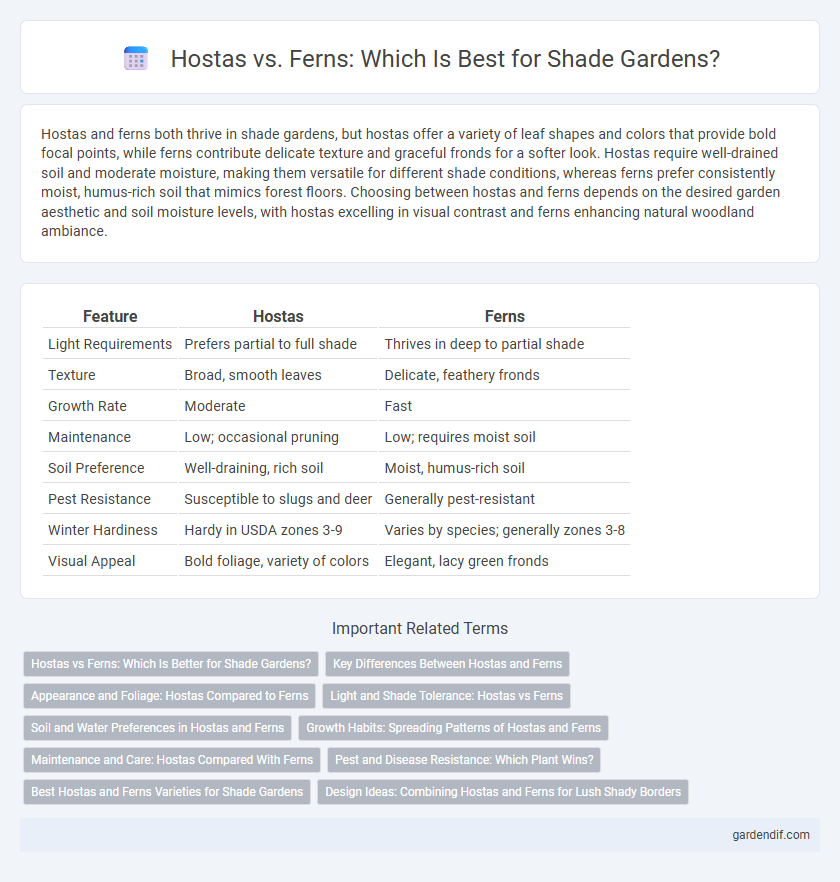
Hostas vs Ferns (for shade gardens) Illustration
Hostas and ferns both thrive in shade gardens, but hostas offer a variety of leaf shapes and colors that provide bold focal points, while ferns contribute delicate texture and graceful fronds for a softer look. Hostas require well-drained soil and moderate moisture, making them versatile for different shade conditions, whereas ferns prefer consistently moist, humus-rich soil that mimics forest floors. Choosing between hostas and ferns depends on the desired garden aesthetic and soil moisture levels, with hostas excelling in visual contrast and ferns enhancing natural woodland ambiance.
Table of Comparison
| Feature | Hostas | Ferns |
|---|---|---|
| Light Requirements | Prefers partial to full shade | Thrives in deep to partial shade |
| Texture | Broad, smooth leaves | Delicate, feathery fronds |
| Growth Rate | Moderate | Fast |
| Maintenance | Low; occasional pruning | Low; requires moist soil |
| Soil Preference | Well-draining, rich soil | Moist, humus-rich soil |
| Pest Resistance | Susceptible to slugs and deer | Generally pest-resistant |
| Winter Hardiness | Hardy in USDA zones 3-9 | Varies by species; generally zones 3-8 |
| Visual Appeal | Bold foliage, variety of colors | Elegant, lacy green fronds |
Hostas vs Ferns: Which Is Better for Shade Gardens?
Hostas thrive in shade gardens with their broad, textured leaves and vibrant foliage colors, offering excellent ground cover and low maintenance. Ferns excel in moist, shaded environments, providing delicate fronds that add a soft, airy texture to shaded landscapes. Choosing between Hostas and Ferns depends on soil moisture preferences and desired garden aesthetics, with Hostas favoring drier shade and Ferns flourishing in consistently damp conditions.
Key Differences Between Hostas and Ferns
Hostas feature broad, textured leaves and vibrant flower spikes, thriving in partial to full shade with moderate moisture, making them ideal for contrast in shade gardens. Ferns exhibit delicate, feathery fronds that prefer consistently moist, well-drained soil and deep shade, contributing a soft, airy texture to shaded landscapes. Key differences include leaf structure, moisture requirements, and light tolerance, which influence their placement and complementary use in shade garden design.
Appearance and Foliage: Hostas Compared to Ferns
Hostas feature broad, textured leaves in various shades of green, blue, and variegated patterns, creating bold focal points in shade gardens. Ferns display delicate, feathery fronds with intricate patterns and a lighter, airier texture that adds softness and movement under low-light conditions. The contrasting foliage of Hostas and Ferns allows gardeners to design layered, visually dynamic shade landscapes with diverse shapes and tones.
Light and Shade Tolerance: Hostas vs Ferns
Hostas thrive in partial to full shade with preference for filtered sunlight, making them ideal for dappled shade environments. Ferns exhibit higher shade tolerance, often flourishing in deep shade conditions with minimal light exposure. Both plants are excellent choices for shade gardens, but ferns adapt better to low-light areas where hostas may struggle.
Soil and Water Preferences in Hostas and Ferns
Hostas thrive in rich, well-drained soil with consistent moisture, preferring slightly acidic to neutral pH levels, which supports their broad, lush foliage in shaded gardens. Ferns favor consistently moist, humus-rich, and well-draining soil with slightly acidic to neutral pH, often tolerating more acidic conditions than Hostas, making them ideal for woodland shade gardens. Both plants require regular watering to maintain soil moisture but Hostas are more sensitive to drought stress, while many Fern varieties can tolerate occasional dry spells.
Growth Habits: Spreading Patterns of Hostas and Ferns
Hostas exhibit a clumping growth habit with rhizomes that expand slowly, creating broad, dense mounds ideal for ground cover in shade gardens. Ferns, such as Athyrium and Dryopteris species, typically spread through creeping rhizomes or stolons, forming delicate, airy colonies with more irregular patterns. The slower, uniform spread of hostas contrasts with the often faster, more flexible expansion of ferns, influencing garden design choices for shaded areas.
Maintenance and Care: Hostas Compared With Ferns
Hostas require moderate watering and benefit from regular fertilization, while ferns thrive in consistently moist, well-drained soil with high humidity. Hostas are prone to slug damage and may need pest control, whereas ferns generally have fewer pest issues but require frequent misting in dry conditions. Both plants prefer shaded environments, but hostas demand more attention to soil nutrients, and ferns need careful moisture management to prevent drying out.
Pest and Disease Resistance: Which Plant Wins?
Hostas and ferns both thrive in shade gardens, but when comparing pest and disease resistance, ferns often have the upper hand due to their natural resilience against common garden pests like slugs and snails, which frequently damage hosta leaves. Hostas are more susceptible to slug infestations and fungal diseases such as leaf spot and crown rot, requiring more vigilant care and pest control measures. Choosing ferns for shade gardens can reduce maintenance efforts and minimize chemical interventions due to their robust pest and disease resistance.
Best Hostas and Ferns Varieties for Shade Gardens
Hostas such as 'Blue Angel' and 'Sum and Substance' thrive in shade gardens, offering large, textured leaves with excellent disease resistance. Fern varieties like Japanese Painted Fern and Lady Fern provide delicate, feathery foliage that enhances the garden's texture and thrives in low-light conditions. Selecting these varieties ensures vibrant, diverse greenery adapted to shaded environments.
Design Ideas: Combining Hostas and Ferns for Lush Shady Borders
Combining Hostas and ferns creates visually rich, textured shade gardens with contrasting leaf shapes and varying shades of green that enhance depth and interest. Hostas provide broad, bold foliage while ferns contribute delicate, feathery fronds, making them ideal companions for lush shady borders. Strategic layering of taller ferns behind low-growing Hostas emphasizes natural flow and maximizes the lushness in shaded garden beds.
Hostas vs Ferns (for shade gardens) Infographic

 gardendif.com
gardendif.com